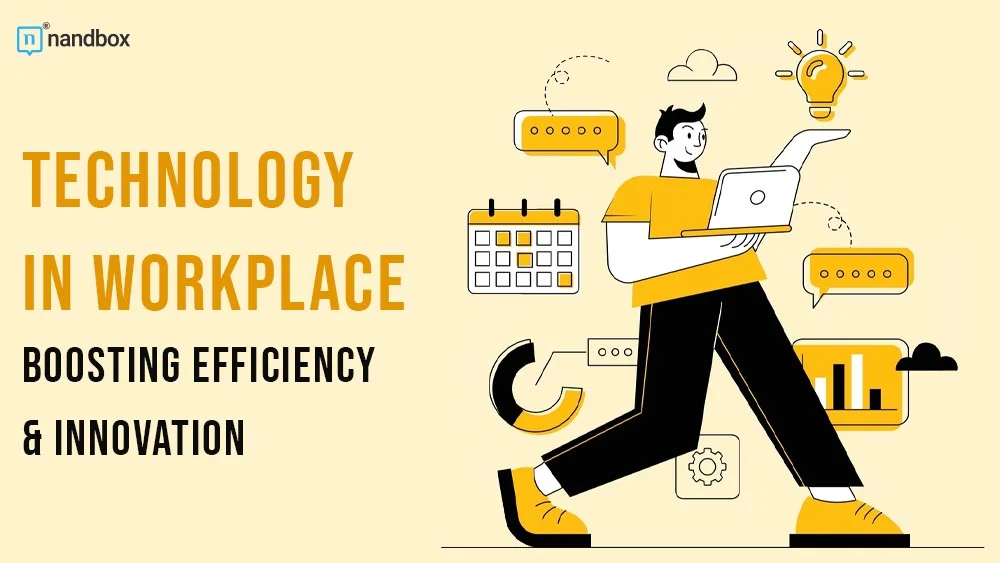To remain competitive in the ever-changing business environment, companies are always looking for ways to improve productivity and efficiency. Workplaces are being transformed by technology integration, which is a potent catalyst that improves collaboration, drives creativity, and streamlines operations. By leveraging a wide range of technological tools and solutions, organizations can unlock their full potential and achieve remarkable results. Technological advancements will remain a key catalyst for reshaping businesses in the coming half-decade. Over 85% of surveyed organizations see adopting new technologies and expanding digital access as crucial trends driving their transformation. These advancements are expected to significantly shape the future of business operations and strategy. In this article, we will explore how businesses can harness the full potential of technology in workplace to supercharge productivity and efficiency.
Cloud-Based Collaboration Tools
Successful teams require frictionless collaboration. Businesses that cultivate a collaborative culture tend to achieve greater success. Zippia reports that organizations fostering collaboration achieve performance rates five times better than those lacking a collaborative environment.
Therefore, implementing cloud-based collaboration tools is a key strategy for fostering such a collaborative environment. By enabling seamless communication and real-time teamwork, these tools help organizations achieve the enhanced performance and efficiency highlighted in the research.
Cloud-based tools have transformed the way teams connect, communicate, and collaborate, no matter where they are. These platforms, such as Google Workspace, Microsoft 365, and Slack, enable teams to communicate effortlessly and work together in real time. By centralizing documents, project management, and communication channels, they eliminate silos and streamline workflows. In addition to communication and teamwork, cloud-based platforms can integrate a visitor management system to ensure seamless security and check-ins. This enhances operational efficiency and supports a secure, collaborative environment. In addition to communication and teamwork, cloud-based Collaboration can integrate a visitor management system to ensure seamless security and check-ins. This enhances operational efficiency and supports a secure, collaborative environment.
Teams can collaborate on documents, track project progress with task management features, and communicate instantly via messaging apps or video calls.
What are some potential challenges or drawbacks of using cloud-based collaboration tools?
Despite their numerous benefits, cloud-based collaboration tools are not without their drawbacks. The potential for security breaches, data privacy violations, and network outages can pose dangers. Also, there may be learning curves with new tools, and organizational culture might need to adjust to support remote and flexible work.
Project Management Software
Harvard Business Review reported that around $48 trillion is invested in projects annually. However, the Standish Group finds that only 35% of these projects are deemed successful. The resources wasted and benefits unrealized by the remaining 65% are staggering.
To address this inefficiency, leveraging project management software can significantly improve project outcomes. By providing tools for better planning, tracking, and resource management, these solutions help increase the success rate and minimize wasted resources.
Project management software is a fundamental component of increasing workplace effectiveness. These tools provide comprehensive platforms for planning, tracking, and managing projects. These tools offer task assignments, timeline views, and real-time updates to keep teams organized and meet deadlines. They also improve resource allocation, minimize project overruns, and enhance team communication.
How can project management software be customized to fit specific business needs?
Project management software can be customized with tailored workflows, custom fields, and personalized dashboards to suit specific business needs. Integration with other tools, along with unique reporting metrics and adjusted permissions, ensures the software aligns with a company’s processes. This customization enhances its relevance and effectiveness across diverse projects.
Automation Tools
Automation tools like RPA and AI can revolutionize the workplace by automating repetitive, time-consuming tasks and boosting efficiency. RPA can automate routine processes, freeing up employees to focus on more strategic and creative work. AI tools can examine data, anticipate future events, and even take action independently.
By automating tasks, businesses can improve efficiency, reduce errors, and gain a competitive advantage. However, it’s crucial to evaluate automation’s impact on jobs and invest in training to help employees adapt to the evolving workplace. As automation reshapes industries, employees may need to find a place to work that aligns with their new skill sets and the changing demands of the job market. Also, Remote flexible jobs offer individuals the opportunity to work from any location while maintaining a schedule that suits their personal needs, providing greater work-life balance and increased productivity.
Can automation tools be used to enhance customer service and support?
Yes, automation tools can significantly enhance customer service and support by streamlining processes such as follow-ups, ticketing, and responses. Chatbots, automated email responders, and CRM integrations handle routine inquiries efficiently. By focusing on complicated matters, support teams can resolve issues more quickly and enhance the overall customer experience.
Optimizing SharePoint with Analytics
SharePoint, a powerful collaboration platform, can be even more effective when equipped with robust analytics capabilities. By analyzing user behavior, adoption rates, and performance metrics, organizations can optimize workflows and enhance SharePoint’s overall value.
Analytics with SharePoint enables organizations to measure user engagement and adoption by tracking metrics like page views, document downloads, and active users. These insights help identify popular content, assess satisfaction, and pinpoint areas needing additional support or training. Moreover, analytics optimize SharePoint’s performance by highlighting usage patterns, bottlenecks, and underutilized features, allowing improvements in speed and effectiveness.
Organizations looking for advanced SharePoint analytics can leverage platforms like CardioLog Analytics, which offers insights into adoption, productivity, and overall platform health.
This tool provides detailed reports and dashboards, enabling organizations to monitor engagement, evaluate SharePoint implementation effectiveness, and make data-driven optimization decisions. CardioLog Analytics offers SharePoint insights on adoption and productivity – click here to learn more.
According to Intlock, CardioLog Analytics delivers precise insights into SharePoint usage tailored to your site’s structure and content. It helps organizations enhance intranet usability, user engagement, and portal collaboration. By combining these insights with CardioLog Engage’s campaigns, businesses can drive user activity, boost ROI, and improve overall productivity.
Cybersecurity Solutions
Cybersecurity is now a critical concern for businesses of every scale. With the increasing threat of cyberattacks, it is essential to implement robust cybersecurity measures to protect sensitive data and ensure business continuity. By investing in comprehensive cybersecurity measures, organizations can safeguard their valuable assets, maintain customer trust, and comply with industry regulations.
Cybersecurity measures vary from simple antivirus protection to sophisticated systems that detect and respond to threats. Modern cybersecurity solutions include advanced threat detection systems, firewall protections, and encryption technologies designed to protect sensitive data and ensure system integrity. Tools like endpoint protection, multi-factor authentication, and real-time monitoring provide comprehensive defense against cyber threats.
The UK government reports a slight increase in the deployment of cybersecurity controls among businesses in 2024 compared to 2023. Up-to-date malware protection usage rose from 76% to 83%, and restricting admin rights increased from 67% to 73%. Additionally, network firewalls went up from 66% to 75%, and processes for handling phishing emails improved from 48% to 54%.
Time Management Applications
Time management applications have become essential tools for individuals and teams seeking to optimize their productivity and efficiency. These apps provide task prioritization, time tracking, calendar integration, and goal setting, aiding users in managing time and focus.
By utilizing time management apps, individuals can improve their focus, reduce procrastination, and achieve better results. These apps enhance team collaboration by offering shared platforms for task assignments, progress tracking, and meeting deadlines efficiently.
These tools can empower individuals and teams to achieve their best possible outcomes.
Embracing Technology for a Productive Future
Leveraging technology is essential for supercharging workplace productivity and efficiency. By integrating these tools thoughtfully and effectively, businesses can streamline processes, enhance communication, and drive significant performance improvements.
Embracing these technologies resolves immediate concerns and paves the way for future prosperity. Keeping pace with technological advancements is crucial for staying competitive and fostering sustained business success.





